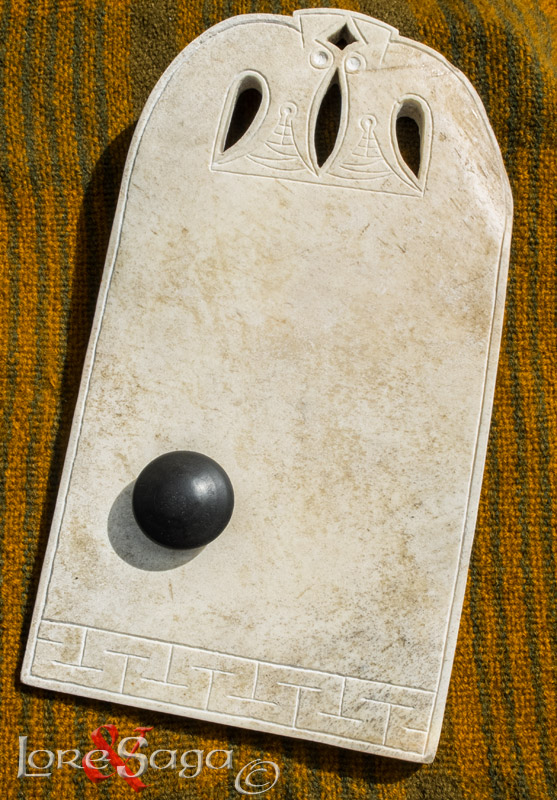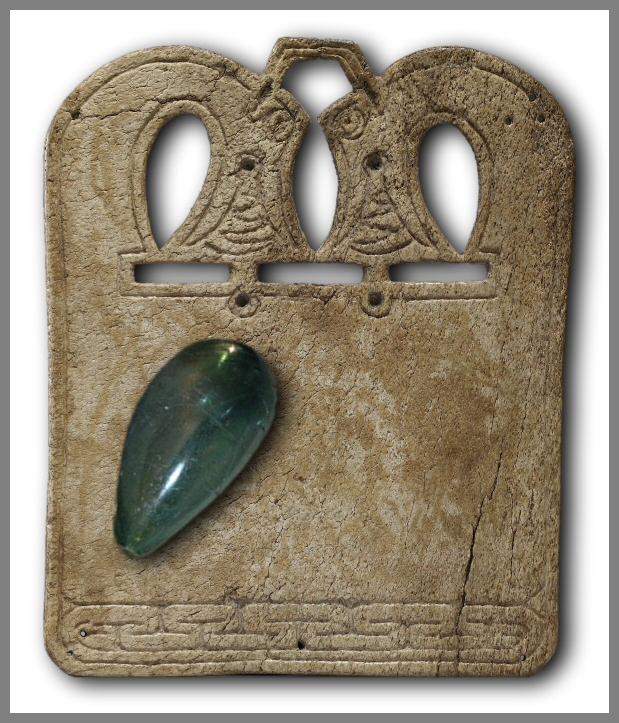Due to the elections I had a day off yesterday so I decided to tick off one of those jobs that have been on my list for a long time.

The "Smoothing Board" is a very distinctive Norse artefact that turns up in Viking period graves and sometimes in black earth contexts.
I've wanted one for my school talks and displays for a long while but sourcing the whalebone was obviously a problem.
I contacted the Natural History Museum as they are given rights to salvage materials from whale strandings. They agreed that the educational use I had for such bone was in keeping with their remit and they promised to let me know if anything ever became available, but nothing ever came of it.
Then, by chance, I came across a few bones on a beach, I am not going to mention where, so don't ask me. One of them was a shoulder blade which was just what I needed. They were all badly weathered and almost unworkable.
Experiments with a couple of offcuts showed I would need to stabilise them somehow but I needed a simple solution that would not compromise the authentic look and feel for living history use. Whatever I tried, I would only ever get one shot at it, I am unlikely to ever find such an ideal bone again. I had just two offcuts left that I could experiment on.
I have to admit that I over thought it. The bones sat on a shelf for a decade while I occasionally pondered what to do. Life got in the way, I have concentrated mainly on the business rather than going to events for a few years and recently we decided to get back on the circuit.
This gave me just the prod I needed to look again at this project and I realised that the simplest solutions are often the best. I just soaked the bone with PVA which filled the delicate blood vessel matrix around the edges and made it solid enough to work on without chipping. Sanded down, it left the surface pretty well unaltered.

There is a board found in Norway that I used for inspiration. I changed a few details like the ears in respect for the fragile state of the material but largely I am happy with the design.
The carving was done mostly with files but with a little help from a Dremel type drill in a couple of tight areas.
I normally highlight such carvings with a mixture of beeswax and crushed charcoal forced into the grooves but decided that would be inappropriate in this case as the usual interpretation of what they were used for is smoothing linen which might get soiled by the charcoal mix rubbing out.
Incidentally, the rubbing stone seen in the picture above may possibly be an original. I found it on a boot sale amongst a miscellaneous pile of metal detector finds, some of them correct for the period. The seller was characteristicly vague about where he found it and had no idea what it was but it looked like others that I have seen. Although I do not like to support potential nighthawks, I felt this was too good an opportunity to pass up.

Sometimes the originals are made of glass, sometimes shaped stone like this one and occasionally just a suitably shaped pebble. I suspect some such pebbles are discarded from excavations for simple lack of recognition.
Anyway, not very bushcrafty perhaps but I thought you might be interested.

The "Smoothing Board" is a very distinctive Norse artefact that turns up in Viking period graves and sometimes in black earth contexts.
I've wanted one for my school talks and displays for a long while but sourcing the whalebone was obviously a problem.
I contacted the Natural History Museum as they are given rights to salvage materials from whale strandings. They agreed that the educational use I had for such bone was in keeping with their remit and they promised to let me know if anything ever became available, but nothing ever came of it.
Then, by chance, I came across a few bones on a beach, I am not going to mention where, so don't ask me. One of them was a shoulder blade which was just what I needed. They were all badly weathered and almost unworkable.
Experiments with a couple of offcuts showed I would need to stabilise them somehow but I needed a simple solution that would not compromise the authentic look and feel for living history use. Whatever I tried, I would only ever get one shot at it, I am unlikely to ever find such an ideal bone again. I had just two offcuts left that I could experiment on.
I have to admit that I over thought it. The bones sat on a shelf for a decade while I occasionally pondered what to do. Life got in the way, I have concentrated mainly on the business rather than going to events for a few years and recently we decided to get back on the circuit.
This gave me just the prod I needed to look again at this project and I realised that the simplest solutions are often the best. I just soaked the bone with PVA which filled the delicate blood vessel matrix around the edges and made it solid enough to work on without chipping. Sanded down, it left the surface pretty well unaltered.

There is a board found in Norway that I used for inspiration. I changed a few details like the ears in respect for the fragile state of the material but largely I am happy with the design.
The carving was done mostly with files but with a little help from a Dremel type drill in a couple of tight areas.
I normally highlight such carvings with a mixture of beeswax and crushed charcoal forced into the grooves but decided that would be inappropriate in this case as the usual interpretation of what they were used for is smoothing linen which might get soiled by the charcoal mix rubbing out.
Incidentally, the rubbing stone seen in the picture above may possibly be an original. I found it on a boot sale amongst a miscellaneous pile of metal detector finds, some of them correct for the period. The seller was characteristicly vague about where he found it and had no idea what it was but it looked like others that I have seen. Although I do not like to support potential nighthawks, I felt this was too good an opportunity to pass up.

Sometimes the originals are made of glass, sometimes shaped stone like this one and occasionally just a suitably shaped pebble. I suspect some such pebbles are discarded from excavations for simple lack of recognition.
Anyway, not very bushcrafty perhaps but I thought you might be interested.
Last edited:




